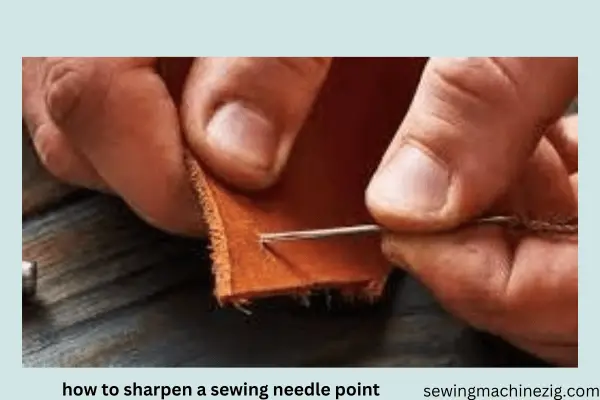
Are you tired of struggling with dull sewing needles that hinder your stitching precision? Fear not, as we bring you an essential guide on how to sharpen a sewing needle point. Whether you’re a seasoned tailor or an enthusiastic beginner, this invaluable skill will ensure your sewing projects are a resounding success. With the right techniques and a little know-how, you can transform a lackluster needle into a sharp and efficient tool, ready to tackle any fabric with ease.
In this comprehensive article, we will delve into the art of needle sharpening, sharing expert tips and step-by-step instructions on how to sharpen a sewing needle point to empower you with the knowledge needed to revive your needles and breathe new life into your sewing endeavors.
Get ready to discover the secrets behind achieving a razor-sharp sewing needlepoint, and unleash your creativity like never before.
Here’s A Detailed Guide On How To Sharpen A Sewing Needle Point.
Materials:
- Fine-grit emery board or sandpaper
- A piece of fabric (preferably scrap fabric)
- Sewing needle
Step-By-Step Guide:
Step 1: Prepare Your Materials:

Gather the necessary materials: a fine-grit emery board or sandpaper, a piece of fabric, and the sewing needle you wish to sharpen.
Example: Take a moment to ensure you have a comfortable working area with good lighting. Place the materials within reach, including the emery board or sandpaper, a small scrap of fabric, and the dull sewing needle.
Step 2: Examine The Needle:
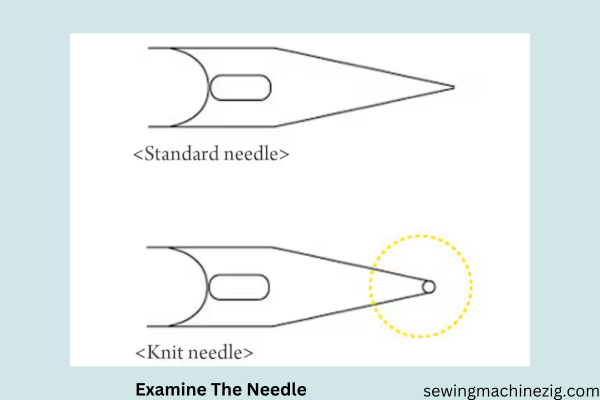
Inspect the needle for any visible bends, burrs, or damage. It’s important to address these issues before sharpening.
Example: Hold the needle up to the light, checking for any irregularities or rough edges. If you notice any, use a magnifying glass or your fingers to gently straighten or smooth out the needle.
Step 3: Determine The Sharpening Angle:
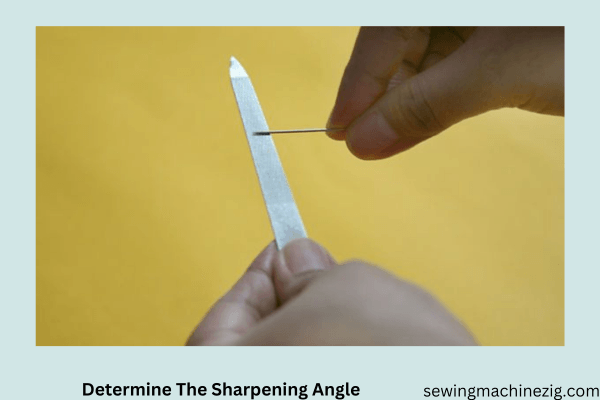
Decide on the desired sharpening angle for your needle. This angle will depend on the type of fabric you’ll be sewing.
Example: For lightweight fabrics such as silk or chiffon, a sharper, more acute angle is preferable. For heavier fabrics like denim or upholstery materials, a slightly broader angle will provide better results. Aim for an angle between 35 to 45 degrees.
Step 4: Secure The Fabric:

Take the piece of fabric and fold it in half to create a double layer. This will provide stability while sharpening the needle.
Example: Fold the fabric in half, aligning the edges carefully. Make sure the folded fabric is larger than the length of the needle so that you have ample space to work with.
Step 5: Position The Needle:
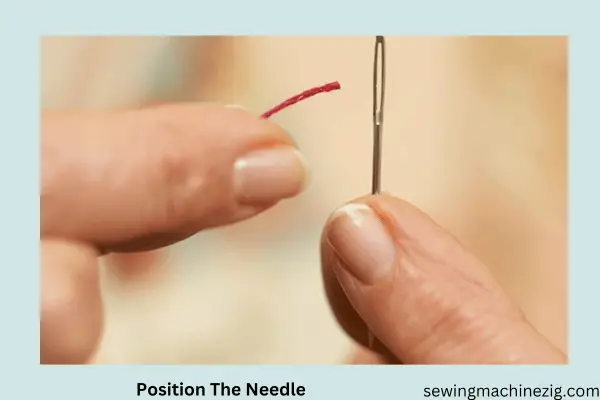
Hold the needle between your thumb and index finger, ensuring a firm grip. Position the needle’s point against the fabric at the desired sharpening angle.
Example: Place the needle’s point against the fabric, aligning it at a 45-degree angle from the folded edge. Make sure to leave approximately half an inch of fabric to the left of the needle point.
Step 6: Start Sharpening:
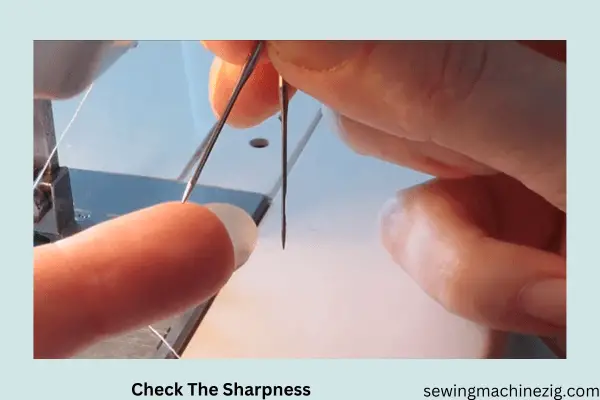
With a gentle back-and-forth motion, rub the needle’s point against the emery board or sandpaper. Apply light pressure to maintain control and avoid excessive sharpening.
Example: Slide the needle back and forth across the emery board, focusing on the point. Imagine you are polishing the needle, ensuring each stroke is smooth and deliberate. Repeat this process for about 10 to 15 strokes.
Step 7: Check The Sharpness:

After sharpening, examine the needle’s point to determine if it has reached the desired level of sharpness. Look for a fine, tapered point that is free from rough edges or burrs.
Example: Hold the needle up to the light and inspect the point. It should appear sharper and more defined. If necessary, repeat the sharpening process for a few additional strokes until the desired sharpness is achieved.
Step 8: Test The Needle:
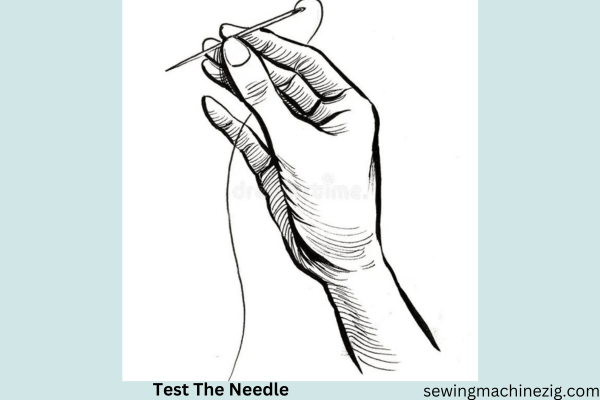
Before using the needle for your sewing project, perform a test stitch on a scrap piece of fabric. Ensure the needle glides smoothly through the fabric and creates neat, even stitches.
Example: Thread the sharpened needle and perform a few test stitches on the scrap fabric. Pay attention to the ease of penetration and the quality of the resulting stitches. Adjust the sharpening if needed until you are satisfied with the needle’s performance. I hope now you’re aware of the importance of how to sharpen a sewing needle point and its benefits.
By following these step-by-step instructions that help you how to sharpen a sewing needle point and using the appropriate techniques, you can revive your dull sewing needles and enjoy the benefits of a sharp needle point. Remember to always exercise caution and take your time to achieve optimal results. Happy sewing!
How To Sharpen Hand Sewing Needles
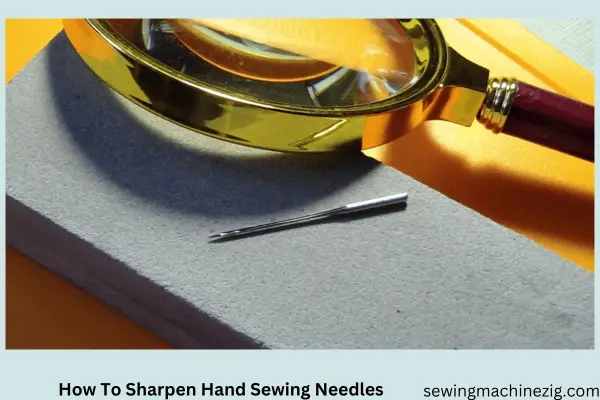
Sharpening hand-sewing needles is a valuable skill that can enhance your sewing experience. Dull needles can cause frustration and compromise the quality of your stitches. In this concise guide, we will explore the process of sharpening hand-sewing needles and it’s a bit different than how to sharpen a sewing needle point. From examining the needle to selecting the right angle and using simple materials, you’ll learn the essential steps to bring your needles back to their sharpness.
Say goodbye to snagged threads and welcome the precision of a well-sharpened hand-sewing needle. Let’s delve into the world of needle sharpening and elevate your sewing projects to new heights. With the right materials and a series of carefully outlined steps, you’ll soon be stitching with precision and finesse. Let’s embark on this enlightening journey together.
Assembling the Necessary Equipment Before diving into the art of sharpening hand-sewing needles, ensure you have the following tools at your disposal:
Materials:
- Fine-grit emery board or sandpaper
- Scrap piece of fabric
- Hand sewing needle
Step-By-Step Guide:
Step 1: Assessing The Needle’s State:
Before initiating the sharpening process, it’s crucial to evaluate the condition of your hand sewing needle. Identify any signs of dullness, burrs, or bends that may require attention.
Example: Gently hold the needle up to the light, scrutinizing its point and body. Observe meticulously for indications of wear, rough edges, or irregularities. Utilize a magnifying glass or your fingertips to delicately straighten or smooth out the needle, if necessary.
Step 2: Choosing The Optimal Sharpening Angle:
The sharpening angle plays a pivotal role in achieving outstanding results. Consider the fabric you’ll be working with and select the appropriate angle accordingly.
Example: Delicate fabrics, such as silk or chiffon, necessitate a sharper, more acute angle. Conversely, when working with heavier fabrics like denim or upholstery materials, opt for a slightly wider angle. Aim for an angle between 35 to 45 degrees to attain optimal sharpness.
Step 3: Preparing The Fabric Support:
To ensure stability and precision during the sharpening process, prepare a sturdy fabric support to hold the hand sewing needle securely.
Example: Take a piece of fabric, preferably a scrap piece, and fold it in half meticulously. Ensure the folded fabric surpasses the length of the needle, providing ample space for maneuvering and stability.
Step 4: Positioning The Needle For Sharpening:
Grasp the hand sewing needle firmly between your thumb and index finger, positioning it against the fabric support at the desired sharpening angle.
Example: Align the point of the hand sewing needle against the fabric support, ensuring it forms an angle of 45 degrees from the folded edge. Leave approximately half an inch of fabric to the left side of the needle point, allowing sufficient room for sharpening.
Step 5: Initiating The Sharpening Process:
With a gentle back-and-forth motion, glide the hand sewing needle’s point across the emery board or sandpaper. Apply moderate pressure, maintaining control to avoid over-sharpening.
Example: Slide the hand sewing needle back and forth across the emery board, envisioning the needle being delicately polished with each stroke. Repeat this process for approximately 10 to 15 strokes, ensuring smooth and deliberate movements.
Step 6: Assessing The Sharpness:
Following the sharpening process, evaluate the hand sewing needle’s point to gauge its sharpness. Look for a refined, tapered point devoid of rough edges or burrs.
Example: Hold the hand sewing needle up to a well-lit area and carefully examine the point. It should exude a sharper and well-defined appearance. If necessary, repeat the sharpening process with a few additional strokes until the desired sharpness is achieved.
Step 7: Testing The Needle’s Performance:
Before incorporating the hand sewing needle into your projects, conduct a trial stitch on a scrap piece of fabric. Ensure smooth gliding and the production of neat and uniform stitches.
Example: Thread the sharpened hand sewing needle and perform several test stitches on the scrap fabric. Observe the ease of needle penetration and evaluate the resulting stitch quality. Make any necessary adjustments to the sharpening technique until you’re satisfied with the needle’s performance. I hope after following these steps “how to sharpen a sewing needle point” you will achieve a better result.
You’ve unlocked the artistry of sharpening hand-sewing needles, revitalizing their potential, and empowering your sewing endeavors. By following these comprehensive steps and leveraging the appropriate techniques, you’ll experience a new level of precision and mastery in your stitching projects. Embrace this newfound skill and elevate your sewing craftsmanship. Happy stitching!
Conclusion:
Mastering the art of how to sharpen a sewing needle point is a valuable skill for any sewing enthusiast. By carefully assessing the needle’s condition, selecting the appropriate sharpening angle, and using the right tools, you can restore a dull needle to its optimal sharpness. Through gentle back-and-forth motions on an emery board or sandpaper, you can achieve a refined and well-defined needle point.
Remember to test the needle’s performance on scrap fabric before incorporating it into your projects. By learning how to sharpen a sewing needle point, you’ll experience smoother stitching and achieve precise and professional results. Sharpen your needle, sharpen your skills, and embrace the art of sewing with confidence. Happy sewing!
FAQs:
Here are some important frequently asked questions about sharpening a sewing needlepoint, along with detailed answers:
Q 1: Why Should I Sharpen My Sewing Needle?
A: The importance of How To Sharpen A Sewing Needle Point. Sharpening your sewing needle ensures that it has a fine and precise point, allowing for smoother needle penetration through fabrics. A sharp needle reduces the risk of skipped stitches, fabric damage, and frustration during sewing.
Q 2: Can I Sharpen Any Type Of Sewing Needle?
A: Most hand-sewing needles, including those used for embroidery, quilting, and general sewing, can be sharpened. However, be cautious with specialized needles such as ballpoint or leather needles, as their unique design may not respond well to sharpening.
Q 3: How Do I Assess If My Sewing Needle Needs Sharpening?
A: Inspect the needle under good lighting. If the needle appears dull, has rough edges, or struggles to penetrate fabric smoothly, it may be time for sharpening. Trust your tactile sense to run your finger along the needle’s point to feel for any roughness.
Q 4: What Tools Do I Need To Sharpen A Sewing Needle?
A: To sharpen a sewing needle, you’ll need a fine-grit emery board or sandpaper. These tools have abrasive surfaces that can refine and shape the needle’s point effectively.
Q 5: What Is The Recommended Angle For Sharpening A Sewing Needle?
A: Aim for a sharpening angle of approximately 45 degrees. This angle allows for a fine and durable point, suitable for most sewing projects. However, the angle may vary slightly depending on personal preference and the type of fabric you’re working with.
Q 6: How Do I Sharpen A Sewing Needle Using An Emery Board Or Sandpaper?
A: Hold the emery board or sandpaper flat on a stable surface. Place the needle’s point on the abrasive surface at the desired angle. With gentle pressure, move the needle back and forth across the emery board or sandpaper, ensuring even strokes along the entire length of the needle. Repeat this motion several times, periodically checking the needle’s sharpness.
Q 7: Can I Use Other Methods To Sharpen A Sewing Needle?
A: The importance of How To Sharpen A Sewing Needle Point. While an emery board or sandpaper is the most common tool for sharpening sewing needles, some sewers may also use specialized needle sharpeners or sharpening stones. However, exercise caution and follow the manufacturer’s instructions when using these alternative methods to ensure proper sharpening without damaging the needle.



